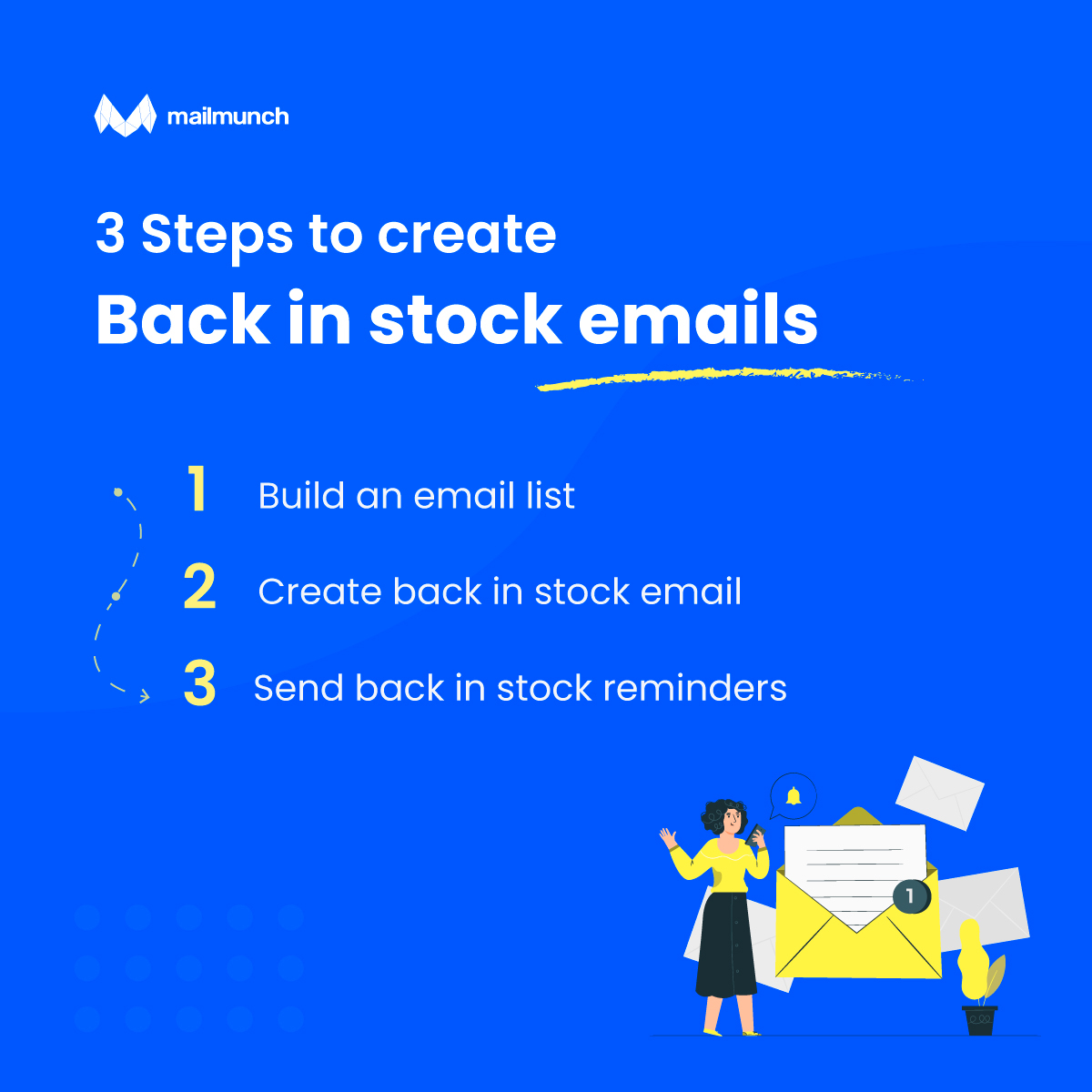.png)


Last updated on
April 25, 2024
While good digital marketing tactics allow you to get ahead of the competition and make customers choose your store instead of other brands, sometimes things don't go your way. Whether it's a surge in demand or troubles with suppliers – one of your most popular products goes out of stock.
When that happens, you are at risk. Not only that you essentially waste away your marketing budget by capturing and converting a lead that was about to press BUY, but you have probably lost them to the competition.
Even worse, you did all the marketing for your competitors. And you won't get any thank you notes from them, that's for sure! You were the one to capture that lead's attention and convert them from just a casual browser into a scorching hot lead ready to buy.
Fortunately, one simple tactic can prevent you from losing that potential customer forever – back in stock emails.
After reading our article, you will know how to create and use back in stock emails correctly. We will give you everything from tactics to examples, helping you launch your own back in stock campaign and improve conversions in no time.
A back in stock email informs potential customers that a product they were previously interested in buying is available again. While this usually refers to physical products that become unavailable when sold out or due to technical or logistical reasons, the same logic can apply to any type of product that becomes unavailable.
For example, if you sell courses with a limited number of participants, you can inform people who didn't manage to sign up at a time when the next session becomes available. Although this isn't a literal "back in stock" email, as there is no stock, the logic is the same – whenever something becomes available after it was out of stock/locked/reserved, you send a back in stock email to inform those who are interested.
The effectiveness of back in stock emails (just like any other type of marketing) depends on the quality of the campaign and the product itself.
Such emails will give you a lead-saving second chance. Instead of immediately leaving for good, some customers will fill your back in stock form. They will provide you with their email so you can later let them know when the product becomes available.
But, back in stock emails are also helpful for reminding existing loyal customers that one of your most popular products has returned. Simply reminding people that something previously sold out is back is usually enough to trigger the fear of missing out – if something sold out the first time, it is likely to sell out again, so better act fast!
Back in stock emails also offer reassurance to the buyers. The aim is to keep engaging with the customers so that they do not forget about the out of stock product. To grab their attention urge customer to buy their beloved product creates a sense of reliability with the brand.
But, they also give them a timely reminder, as people sometimes simply forget. A convenient back in stock notification email can spark their interest, getting them back to the checkout page.
Last but not least, back in stock emails allow you to cross-sell and upsell other products, even if you didn't make the initial sale.
If a customer bought the primary product from one of your competitors, your back in stock email could offer accessories or upgrades from your roster. That might turn the customer back to your store permanently. You were the first one they wanted; instead, they turned to competitors. As you did something right to attract them initially, it won't be too hard to win back their interest.
Back in stock emails shouldn't be limited only to announcing that one of your items is back in stock. Although that's their primary purpose, hence the name, there are a few other things you should focus on if you want to get the most out of them.

The first thing the customer needs upon giving you their email is reassurance. Immediately after they sign up, they should receive an automatic email that will notify them that you are aware of the issue and working on restocking. This email is critical as it can defer the customer from looking elsewhere if their purchase isn't urgent.
Buyers faced with an out-of-stock product often feel disappointed and leave the site, hopefully after filling up the form. They sometimes forget about other products they added to the cart before stumbling upon the unavailable one.
Fortunately, the first email you send them can not only reassure them and tell them how you are working on the issue, but it can also remind them about the abandoned cart. That way, they will have a chance to finalize their purchase in your store. That will also make it more likely for them to wait for you to resupply instead of finding the same item somewhere else.
The first email you send after signing up for back-in-stock notification can also contain information about similar products to the one they are after from your roster. That way, a customer might choose an alternative, preventing them from going elsewhere to find the initial product they were after.
If you are unsure what to offer, look through previous buyer behavior. If someone wants to buy a tennis racket out of stock, offering them a bag instead is not good. Instead, show them rackets of the same kind and in the same price and quality range.
Then, if they decide to purchase another racket, it's time to offer them a racket + bag + 10 balls bundle as an upsell. But, offering a bag alone instead of a tennis racket is not a good substitute.
Wishlist remarketing is very effective because it reminds buyers about the items they already expressed interest in, creating a personalized experience.
Like abandoned carts, customers often forget about the products they added to their wish list. While you can notify them about any price changes or sales separately, it's also good to mention the products in wish list in your those emails.
Mentioning the wish list makes sense if the products on it have something to do with the out-of-stock product. If that is the case, offer bundles or upsells – you will sell more than one product, and the customer will get a better price, creating a win-win scenario.
Even though the customer knows that your products can run out of stock, it's good to remind them. When you notify them that the product is running out, create awareness that it's one of your most popular items and you can't guarantee it will remain in stock due to the interest or escalated sales.
Also, if you are running periodic sales, remind customers that the offer will be only available until a specific date – when it passes, they will have to wait until the same time next year. A good old countdown timer does a wonderful job here.

The first thing you need to have on your site before sending anything is a form to collect customers' emails whenever they encounter an out-of-stock product. This is crucial – without it, the customer will just leave. For the same reason, it makes sense to have the form visible or even include it in a popup.
Here, you can give an estimate to buyers when you think the product will return and also offer them to subscribe to your newsletter by ticking a box, helping you build an email list.
The most important thing about any marketing email, back in stock included, is to ensure it gets opened by writing a catchy subject line. Ideally, you want to attract attention immediately by triggering urgency through power words such as:
While some of these might seem too salesy, the buyer will be glad to open the email. After all, they missed the last opportunity, so they signed up for the back in stock notification. They won't be happy to miss the sale again, only because you went too flat on the subject line and they overlooked the email.
As for the body itself can contain more information about the product that is back in stock. That can be pictures, videos, testimonials, and buyer reviews.
But, the most important thing is having a robust and visible call to action that triggers urgency – "don't miss this special opportunity again – BUY NOW."
Writing back in stock email subject lines doesn't guarantee all recipients will open them. To ensure the restock product doesn't get unnoticed, it's good to send reminders the week after the resupply.
Here, you should use similar subject lines to attract attention. Highlight how the products are going away fast and how you are not sure how long the stock will last. Even better, display accurate numbers that present remaining items in stock or how many more days the sale will last.
Don't forget to add a CTA that will invite the reader to act now, again notifying them how they can miss the opportunity if they procrastinate on their decision.
The first noticeable thing about any email is the subject line. If you are already struggling with the inventory you do not need to suffer the same with the email subject lines. It must be clear, concise and convey the point. It is one of the convenient methods to promote the long-existing products.
Take a look at some of the catchy back in stock email subject lines.
While we gave you some concrete advice on creating your campaigns, it's always good to have a back in stock email template to kickstart your creativity.
Mix and match these tried and tested campaigns, but also add your flavor to the mix, and we have no doubt you will create an effective back in the stock campaign for your brand.

Here, we don’t have anything fancy but a well-composed email that does everything the way it’s supposed to – we have a product picture, a call-to-action, and an urgency trigger, accompanied by a powerful “We can't keep this Boxer in Stock” subject line. Simple but effective!

Not only that Ujji write a headline that rhymes, but they also put their back in stock email to a good cause, donating a percentage of every sale to the Movement for Black Lives. Contributing to a charity or a humanitarian organization in your community is a nice thing to do on its own and improve your brand reputation. Why not combine it with a back in stock sale, just like Ujji did in their campaign.

This Sandland email has sleek coloring and witty copy. It also has one of the fundamentals of social proof – a customer testimonial right in the back in stock email itself. If you can, add testimonials to your campaign too.

This Huckberry email shows exactly how you should write a back in stock item for a particular item in your customer’s wish list. It’s direct, triggers urgency, and displays the exact items in the size and color the customer wanted, with a clear call to action. Copying this formula is guaranteed to work, as it gives customers exactly what they like on a plate.

What we like about this Public Goods email is that it displays a witty subject line “Go Nuts. Nuts, Trail Mixes & More Are Back In Stock Now.” Combine it with several other elements such as customer reviews and testimonials on concrete products. Also, their product roster with prices, right in the email itself, all packed in their brand colors. That way, the customer gets all the information they need, and all that is left is for them to click the SHOP NOW button.

The “Stretch your legs” subject line and "Sweatshirt-level comfort” tagline make this Everlane email a masterpiece. Copy this is billboard-worthy, but here we find it in a back in stock email. They also display three important characteristics of their chinos and customer reviews. Well done!

Here’s how an effective color shame accompanied with a simple message and an interesting call to action button (GIMME!) is more than enough to attract attention and leave an impact, which is why we liked this Uniqlo back in stock email.

This Polaroid email screams urgency. It all starts in the subject line (Back in stock… for now.), continues in the tagline (Here today, gone tomorrow.). It never stops until the end of the email, making the reader feel like they will miss a once in a lifetime opportunity if they don’t buy one of the cameras mentioned in the email. FOMO at its finest!

This Everlane email promotes the return of their 100% human collection. But, it also adds a section of accessories designed specifically for the 100% human clothing line, giving real fans an easy way to upgrade their new look and showing you how to offer extras with your products.

This Moment email shows that you don’t have to be a wordsmith wizard and write the most brilliant copy for your back in stock emails. After all, you don’t need to write copy – just add pictures of your restocked products to your promotional emails, and a visible CTA button.
Which strategy and email marketing templates from this article you decide to use are up to you. But, as long as you stick to the game plan, you should see results.
After all, back in stock emails are a proven way to convert on opportunities you would otherwise miss while simultaneously promoting your products and boosting sales. They rely on marketing fundamentals such as scarcity and social proof, and even though they are fairly simple, they will continue to be incredibly effective.
A bookworm and a pet nerd at heart, Summra works as Content Writer at Mailmunch. She loves to play with keywords, titles, and multiple niches for B2B and B2C markets. With her 3 years of experience in creative writing and content strategy, she fancies creating compelling stories that your customers will love, igniting results for your business.
Tags:

M. Usama
April 19, 2024

M. Usama
April 19, 2024

M. Usama
April 18, 2024